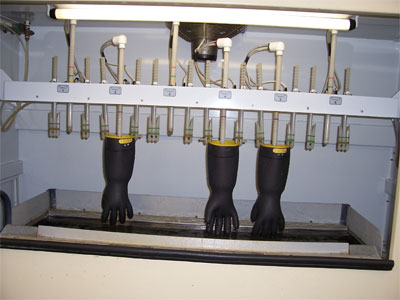Insulated Glove Testing
High Voltage Insulating Rubber Glove Testing
Rubber insulating gloves are to be tested before first issue and every 6 months thereafter. If the insulating equipment has been electrically tested but not issued for service, it may not be placed into service unless it has been electrically tested within the previous 12 months.
Testing Process:
Gloves and sleeves are individually tracked by ID-labeled. Other items are given individual test numbers.
Individual tracking allows us to:
• Identify ownership of items tested,
• Provide detailed itemized test reports,
• Maintain reliable test records.
All items are identified with the test date, the test voltage, and the name of our laboratory.
All items returned to customers are cleaned, visually inspected, and electrically tested. Items failing test and inspection (rejects) are clearly marked and returned to customer, unless local disposal is authorized.
Per OSHA (29 CFR 1910.137) requires all testing procedures above.
Testing Electrical Safety Gloves
One of the first lines of defense when it comes to preventing contact with energized electrical components and/or electrical power lines are rubber insulating gloves, commonly known as High Voltage Gloves . High Voltage Gloves must meet the requirements of the current ASTM D120 specifications and NFPA 70E standards. OSHA enforces these requirements as a part of their CFR 1910.137 regulation. These standards dictate manufacturing criteria as well as testing and retesting requirements for Lineman Gloves.
OSHA requires the use of rubber insulated gloves for those persons working on or near energized circuits and/or other electrical sources that are considered either high or low-voltage applications. That means there are many other occupations that need to use rubber insulated gloves as well, such as HVAC Technicians, Automotive Technicians, Electricians, Maintenance Mechanics, Railway Technicians, and even Telecommunications personnel.
OSHA regulation 29 CFR 1910.137 requires that all insulating gloves must be electrically tested before first issue and retested every six months thereafter. OSHA 1910.268 (Tele-com) – Natural rubber insulating gloves must be electrically tested before first issue, twelve months after first issue, and every 9 months thereafter.
Any unused glove that has not been tested within twelve months must be retested before being used.
Date Stamping
Date stamping lineman gloves is not a requirement of ASTM D120, however, it is a very useful technique for employers and/or end-users to assist in maintaining compliance with OSHA test intervals.
All Gloves stocked and sold by Mitchell Instruments are date stamped. Click below for a listing of available gloves:
Daily Safety Inspections
Rubber insulating gloves should be visually inspected before each day's use and also after any situation that may have possibly caused damage to the gloves. Care and maintenance is critical to ensure an insulated glove retains its protection properties.
Manufacturers suggest lineman gloves be stored out of direct sunlight, in a cool and dry location away from sources of ozone. They should be stored in a glove bag (one pair per bag) and then hung-up versus being laid down on a flat surface. Rubber insulated gloves should never be folded in the storage bag. Creasing insulated gloves may cause cracking which could shorten the useful life of the gloves.
Before use, gloves should be visually inspected for tears, holes, signs of abrasion, ozone damage or possible chemical contact. (ASTM,F1236 standard provides inspection details). In addition, OSHA requires an air-glove inflation test as a part of the inspection process.
Mitchell Instrument Co. Inc
2875 Scott Street Suite 101
Vista CA 92081
1-888-270-2690














